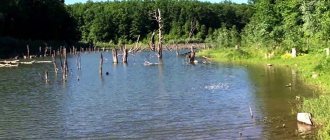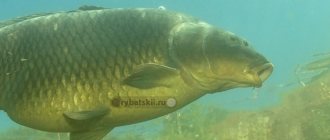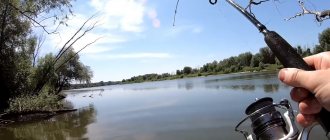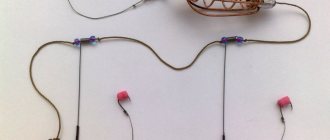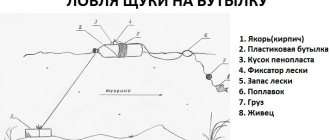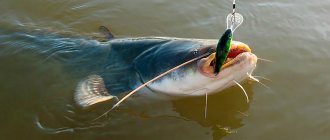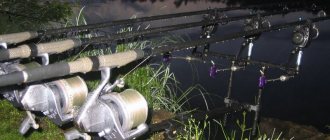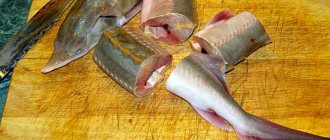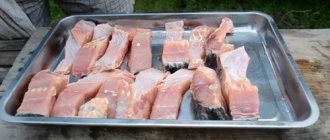Yuri 09/07/2020 696
Every fisherman knows that the balalaika is an original Russian musical instrument. But not everyone can answer what a balabaika is. Balabaika or otherwise putavusha is a very effective, simple tackle for catching carp from a boat. Previously, it was used for catching exclusively predatory fish, but over time it was tested by carp anglers, who began to use this method of fishing everywhere.
Despite the crude manufacturing, the tackle works equally well in deep reservoirs and on rivers with weak and medium flows. Catching carp with baits is similar to catching pike or pike perch with mugs, but differs in tactics and installation of gear.
Preparing tackle for catching carp using cake and mastering the technique
Catching carp on top is one of the ancient methods of effective hunting, which allows you to confidently count on catching this cautious and powerful giant. The yield of the method is based on the characteristics of the bait, which has a strong odor that attracts fish to the fishing area. The method belongs to the baitless type of fishing and is not accepted by all fishermen as a sporting activity, but still many carp anglers remain faithful minions of the makushatnik and continue to improve this interesting style.

In practice, catching carp with cake is not so difficult; the main thing in this matter is to have a high-quality product, reliable and strong tackle and to know the habitats of this fish. In many ways, the equipment and tactics of carp fishing are similar to carp fishing, and these types of fish are the closest relatives and are similar in their behavior and diet. But still, catching a river carp is rightfully considered a privileged catch and requires knowledge of the secrets of some subtleties, even for such a catchy method using a macaque.
The essence and types of cake
Privads of this type are a by-product of the process of obtaining vegetable oil, the pressed mass of which is pressed into dense blocks and supplied to retail fishing outlets in the form of layers for further cutting into the required sizes or already packaged briquettes. The compressed substance has a persistent aromatic odor from oil residues and when placed in water for a long time, it begins to decompose into small particles and release fine turbidity.
Read more about what fishing cake is and how you can prepare it yourself.
Cake fishing is based on supplying the above-described bait to the fishing point, including several hooks on short leashes. When a fish approaches the smell, it begins to suck on the tasty briquette and in this process absorbs the hooks, thereby becoming a fishing trophy. Briquettes made from sunflower seeds have become widespread. They occupy the bulk of the product among the tops. But there are also varieties made from flaxseed and soybean seeds, which are more expensive than the sunflower product, but are also effective in practical use.
What types of equipment are used
Privads of this type are a by-product of the process of obtaining vegetable oil, the pressed mass of which is pressed into dense blocks and supplied to retail fishing outlets in the form of layers for further cutting into the required sizes or already packaged briquettes.
The compressed substance has a persistent aromatic odor from oil residues and when placed in water for a long time, it begins to decompose into small particles and release fine turbidity. Cake fishing is based on supplying the above-described bait to the fishing point, including several hooks on short leashes. When a fish approaches the smell, it begins to suck on the tasty briquette and in this process absorbs the hooks, thereby becoming a fishing trophy. Briquettes made from sunflower seeds have become widespread.
The equipment for carp, and in particular its formation and principle of operation, depend on a number of factors arising from the physiological characteristics of the fish, its habitat and preferences in the choice of nutritional objects. It is worth noting that carp are quite powerful and fast fish, capable of crushing even the most reliable tackle with poor handling technique. At the same time, the fish is very careful and timid, which is why it tries to stay at long distances from coastlines.
The carp prefers to inhabit snags and driftwood, as well as bottom topography with holes, adhering to moderate currents. It feeds mainly on muddy bottoms, as well as on shell rocks and shallow waters with young aquatic growth. The food supply consists of plant and animal food. The plant diet includes cereal seeds, as well as berries that fall into the water. Carp love young shoots of cattails and reeds.
Animal food consists of all kinds of insect larvae developing in the water, as well as mayflies, mollusks, especially zebra mussels, leeches, molting crayfish, fish eggs and the juvenile fish themselves. The use of high reliability parameters for tackle cords is greatly influenced by the presence of a file on the front ray of the upper fin of the fish, which often causes cut-offs of equipment when fighting hooked fish.
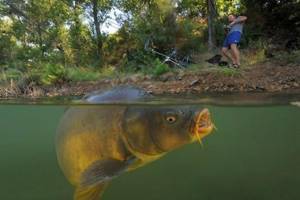
Based on all the features presented above, carp fishing relies on bottom rigs for long-distance fishing strategies and float rods, mainly fly rods, if fishing is planned to be done from a boat or a cliff hanging over a reservoir. Fishermen use both universal purchased and homemade gear, tailored specifically for carp.
Feeder tackle
The feeder belongs to the bottom type of equipment, combining two important features that help catch carp - the ability to fish at long distances, over 100 meters, while simultaneously forming a feeding table that attracts fish. The feeder fishing rod for carp is distinguished by a length parameter starting from 3.5 meters and above, as well as a large dough, selected from 80 grams. The medium action of the blank, shifted towards the slow one, helps to effectively fight with already caught fish and notice its careful bite.
A spinning reel is selected under the rod with the obligatory presence of a baitrunner and a safety cable on the butt of the tackle. The device size is at least 3500–4000 units. The spool should hold about 200 meters of 0.25 mm braided cord. The power and traction mechanism covers the harsh conditions of carp fishing.
Shock leaders and ties are used in the rigging of the lines, allowing you to feel subtle bites in current conditions. The use of feeders varies from classic metal or plastic meshes to method and spring options. A thin braided leash with a length of 20 to 40 cm is placed on the feeder, equipped with a hook number 8–10.
Bottom gear for catching large carp is assembled according to the principle of carp equipment, which is based on replacing the feeder with a blind sinker, which allows the fish that takes the bait to self-hook. Such installations are completed on specialized carp rods or spinning rods with large tests. The rod is equipped with carp low-speed spinning reels equipped with a braided cord having a high breaking load.
Often, in this type of equipment, hair equipment is used, when installing gear for fishing with corn or boilies. When a fish tries the bait, it hooks itself. The bite is controlled by various signaling devices based on the principle of operation. The signaling device can be either a regular bell or an electronic light and sound system with a pager. Carp equipment is convenient for fishing with several rods at the same time at any time of the day.
Choosing equipment: catching carp with cake is a rather complicated process. To cast heavy tackle and catch large fish, take a strong fishing rod. Carp spinning rods and feeders are most often used. The fishing line is chosen to be strong, 0.25-0.38 mm thick. Take a powerful, large reel with a baitrunner. The makushatnik can be used with a blind or sliding installation.
Basic requirements for cake
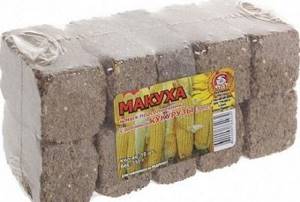
The main requirements for cake are put forward in terms of its freshness. The fresher the briquette, the stronger the smell. Sunflower bait smells pleasantly of halva. When choosing a packaged product, pay attention to the absence of mold and distinct color. The color of the suitable bait is in bright black and white tones, without dullness or blurriness. An important criterion is the density of the substance.
Important! Tactilely, it is a non-crumbly and elastic product without fragility and pronounced plasticity.
Store the baits in the refrigerator on the lower shelves in plastic bags to prevent moisture penetration. If you need to obtain certain pieces, it is most convenient to use a hacksaw, which cuts the product without creasing the edges in the desired geometry. Also, using the same hacksaw, carefully, without crumbling the edges of the product, cuts are made to secure the attachment in the loaded holder of the mounting equipment.
Benefits of using bait
Fishing for carp on the makushatnik has a number of clear advantages over other types of hunting. First of all, this product in installation represents both bait and bait. An important factor is that, due to the design features of the equipment, it is possible to attach the cake when fishing for carp in each installation quite reliably, which facilitates unhindered long-distance casts.

Important! The nozzle works for a long time and does not require frequent replacement. If there are no bites, the cakes are changed every three hours.
Even the daily consumption of briquettes per rod will not exceed a couple of hundred grams. Simple storage and technically simple processes of dividing the bait layer into the required pieces also add comfort to the fishing process. The availability and low cost of the product, as well as the possibility of preparing it yourself, add advantages and continue to popularize the bait for ever wider use in fishing.
Tackle for catching carp with cake
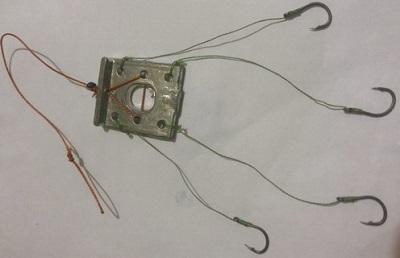
Tackle lengths of 3.5 meters ensure casting range, and tests over 100 grams ensure reliability when feeding heavy rigs. The reel must be equipped with a baitrunner and have a capacious spool to collect at least 100 meters of fishing line with a diameter of 0.3 mm. The manufacture of makushka equipment involves the use of bases made of monofilaments of 0.3 -0.5 mm. The monofilament ensures safe fishing for even a significant trophy weighing a couple of tens of kilograms. Blind or sliding lead flat carp sinkers are used as fastening platforms for baits, with mounting holes for leads and slots for securing the briquette. Leashes are used from braided lines of 0.12-0.15 mm, 5–7 cm long. From one to seven units of this element can be used on the tackle.
Hooks for leashes are knitted in sizes 4–6, in types with a short shank and in a discreet dark color. One of the features of the makushatnik tackle is the use of a shock leader in its equipment, which ensures comfortable fishing on currents and on the bottom with shell rock. And the coastal fight against powerful fish becomes more confident on fishing lines that are thicker in relation to the main line. The finally assembled tackle looks like a briquette of bait rigidly fixed on the platform, where hook leads are inserted into its body at the corners.
Important! The nozzle layer is secured with rubber bands. Hooks are placed in the corners based on the fact that the fish begins to savor the bait from these sharp edges.
How to make tackle for carp with your own hands
It is easy to assemble the tackle for carp yourself from common fishing accessories; besides, by individually completing the equipment, the angler will be able to take into account the nuances necessary for fishing for the specifics of the chosen place and the planned size of the trophy in the catch. As we have already mentioned, the algorithm itself for sets of bottom and float tackle is similar to the classic assembly of devices for most types of carp fish, the only differences are in their parameters of increased reliability and high breaking load of the cords. In continuation of the article, we will focus on the most popular types of making and assembling carp tackle with our own hands.
Float rod
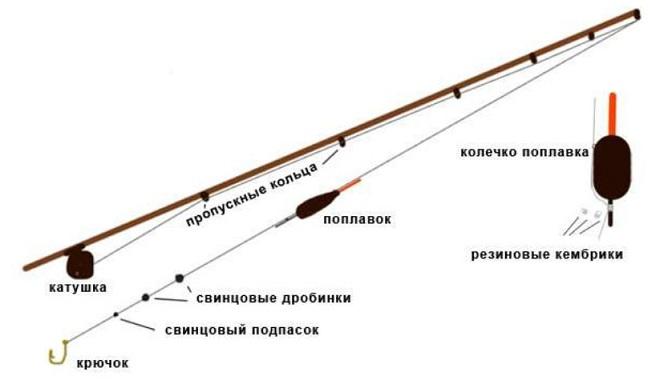
Fishing tackle for carp, based on a fly rod, is used for fishing at short distances from shorelines over ledges and from cliffs above the water, as well as from swimming devices. More convenient are water areas with low current strength, backwaters and creeks in shallow waters, where carp are suitable for searching for food. The fishing rod is taken in length from 4 to 7 meters with dough from 80 to 100 grams. The rod is equipped with a monofilament fishing line, using an attachment to the quiver tip through a rubber shock absorber, which significantly increases the chances of success in landing powerful fish.
The main line is taken with a diameter of at least 0.3 mm. The float is of a spindle-shaped type, no heavier than 3 grams. The lower part of the float should be painted in discreet colors close in shades to the color of the water, which is not so alarming to shy fish. The load is distributed along the fishing line in the form of a garland that decreases in weight towards the leash. Cut lead pellets are ideal for these purposes. A leash made of 0.2 -0.25 mm monofilament is attached to the base in a loop in a loop. The leash length is sufficient at 20–25 cm. Hooks are made of strong elastic steel, selecting their design based on the type of bait used.
How to make a bait for carp
The bait for carp is formed on a slow action spinning rod with weights of 40–80 grams. The length of such a rod should be within 3-3.5 meters, which will guarantee the possibility of long-distance casting. The spinning rod is equipped with a power spinning reel with a baitrunner and a gear ratio of up to 3.5-4.5 units. The main cord is taken to be braided, which transmits bites from long distances much more effectively. The installation itself may vary in its options, including a combined blind weight in the form of a feeder or a classic weight with a fastening loop. The leashes are knitted from thin braids, up to 0.15 mm thick, painted in discreet color tones similar in color to the silty or clayey bottoms being fished.
Important! When fishing on shell banks, use shock leaders and leashes made of monofilament, which are more resistant to abrasion on the ground.
The length of the leash should not exceed 40 cm, based on the principle that the more active the fish, the shorter the leash. After casting, the bottom tackle is installed on a stand on the shore and equipped with an audible alarm, and is necessarily secured by attaching it to a cable that prevents the fish from pulling the cast into the water.
Makushatnik
One of the catching gear for catching carp is considered to be equipment using a macaque. Pieces of pressed cake from sunflower seeds are attached to a special flat-looking platform - a sinker, which is made in the shape of a dovetail and has devices for rigid installation of the bait. In the bait itself, in its corners and the center of the upper edges, there are holes where the hook is mounted. Usually, for carp hunting, four to six hooks are placed on the top of the head. The hooks are tied onto monofilament leashes with a diameter of 0.25-0.30 mm, the length of which does not exceed 7–10 cm. The leashes are attached to the platform in special mounting holes.
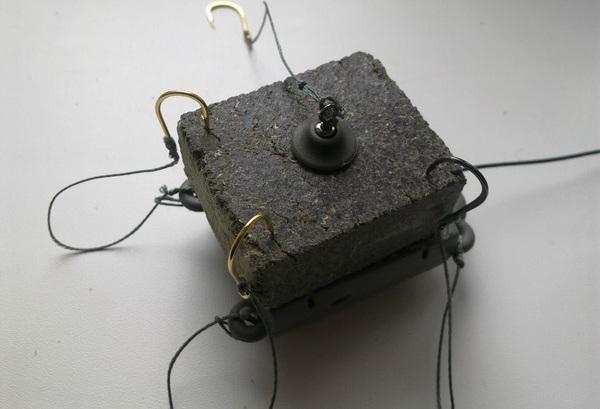
Depending on the strength of the current in the fished area, the mass of the platform is selected, which should not be moved by the stream when set up. Typically, the weight of this combination sinker is in the mass range from 80 to 160 grams. To cast a rig with a spinner, use a feeder rod or a mid-standing spinning rod. Braided fishing lines are used as a cord, wound using a power inertia-free reel. Lures for fishing are chosen with the smells of vanilla, peas or honey. Carp especially love these aromas mixed into sunflower cake.
Match fishing rod
At long distances, in addition to using donks with a feeder, anglers successfully use the method of catching carp using a match fishing rod. When fishing for this powerful fish, choose fast match gear 4-4.5 meters long with the highest test in this class. The fishing rod is equipped with a spinning reel with a finely adjustable clutch, 3500–4000 units in size. The main cord is monofilament with a thickness of at least 0.25 mm. The leash is made of the same material, but not thinner than 0.18 mm. The equipment includes floats with long and bright antennas weighing from 8 grams.
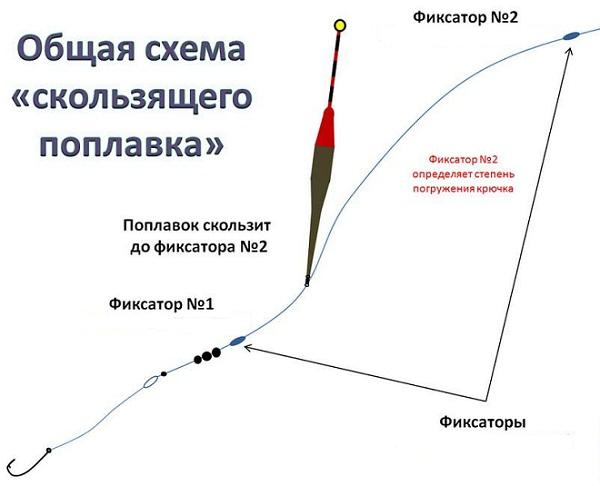
Important! When fishing at depths of up to 3 meters, a blind type of equipment is used; if the depths are higher than this parameter, sliding rigs are used.
This tackle for fishing from the shore has a number of nuances in the fishing technique that relate to the specifics of catching carp. In particular, anglers never clip the line to fix the casting distance, since when fishing, the fish can take a significant part of the line, which will lead to a break in the installation when installing the line in the clip. In addition, when hooking a trophy, it is pumped out by the joint work of the rod and reel without forcing it with accelerated reeling.
Spring
A tackle with a spring-shaped feeder is effective in catching carp. The hunting method is based on feeding the feeder into the fishing zone, into which hooks are embedded that catch the trophy, sucking the bait from the spring. Hooks can be either with attachments in the form of foam balls or hair rigs with boilies or empty, which depends on the preferences and activity of the fish.

Important! As a rule, types of spring-type feeders are used for fishing stagnant water areas.
Spring feeders for carp are loaded with bread, sweetened pearl barley or millet porridge. Two or three hooks are placed on one feeder on monofilament leashes no longer than 5–7 cm and 0.20–0.25 mm thick. In some fishing conditions, anglers use a garland of spring feeders, sequentially mounted on one cord in the amount of 2-3 pieces. As in the method of using a rig with a top rod, feeder and spinning rods with similar operating parameters are suitable for fishing. The rods are equipped with sound alarms that are triggered when a hooked fish catches itself. The fishing itself can be carried out around the clock, and this method is especially successful during the stabilization of intense heat during the day, in the middle of summer.
Selection of promising places for fishing with a mace
Catching carp with cake begins with selecting a promising place. As a rule, flocks of carp live in large rivers with slow and medium currents, preferring to stay at depths of three meters and above on solid bottom foundations with the presence of shell rock.
Important! When selecting a fishing spot, they focus on differences in depth and edge boundaries, where the main channel of the river turns into quieter backwaters.
The presence of isolated snags and artificial, often discarded building or shipping structures, are also included in the area of interest for both fish and carnivores. Water areas in the area of water dams, bridges and embankments with smooth descents of shallows into depth also meet the criteria for a fishing spot. The bottom topography is studied in advance using marker rods or echo sounders.
How to catch carp on a stand
The process of catching carp with a balabaika begins with the angler loading the necessary gear and groundbait with bait into the boat, and begins searching for carp sites. To find a place to feed, you must remember that carp is a sedentary fish, which does not change its permanent habitat unless absolutely necessary.
Carp loves wild, secluded places, snags and depths. On the river, you should look for it where the current slows down, near washed-out steep and steep banks. He also loves areas with sloughs and holes on river bends.
In the summer heat, carp can be found near the border of reeds and among thickets of aquatic plants. In such places it can stay during the day, at a depth of 3 meters or more. Towards evening, when the heat subsides, “wild” carp come out to the shallows. Where you definitely shouldn’t look for carp is near beaches and other places for active recreation of people.
- This is interesting! The easiest and most efficient way to find carp sites is to arrive at the river before dawn. As a rule, at dawn the carp plays, that is, splashes. Mikhail Sholokhov also described this marvelous action in his famous novel “Quiet Don”.
So, having chosen a place and anchored, the fisherman baits the bait hooks, sets the depth, fixing the fishing line between the plate and the buoy, and lowers the tackle into the water.
It’s not difficult to notice a bite on the bait; after sitting on the hook, the carp begins to pull the tackle. Having caught up with the buoy, you need to slowly start landing the fish, pulling it towards the boat. Near the boat itself, the fish must be carefully placed in a landing net and pulled out of the water. By this point, the carp most often no longer offers strong resistance.
In conclusion, I would like to remind you about safety measures when fishing from inflatable floating devices. While in a rubber boat, special care should be taken when landing fish and manipulating tackle. Carp hooks are not among the smallest, and it’s easy to pierce PVC material or rubber with them.
TAGS:
Seasonality of fishing
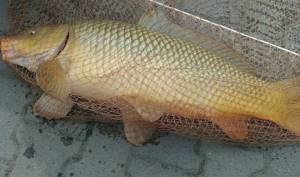
Fishing time is considered successful when the water is warmed up above 12 degrees. At this time, carp begin active feeding, intensively moving around the reservoir.
Important! As a rule, gear for catching carp using cake is most effective from July to September.
During this season, the fish switches to eating plant foods and is more willing to follow the smell of fresh corn. On sunny days, bites most often occur in the early morning hours and at the transition of the evening to distinct twilight. In cloudy weather, fish can bite throughout the daylight hours. Intense heat transfers flocks of carp to a purely nocturnal lifestyle and, accordingly, feeding. Heavy rains and sudden cold snaps with northern and eastern winds make the bite passive. Any warming with a change in wind to the south will activate the bites.
Gear for catching carp from the shore: what do you need to know?
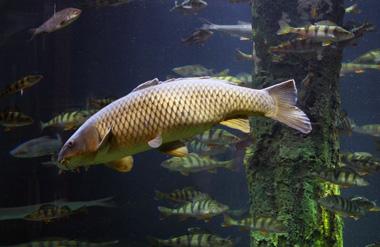
Shortly after the ice melts, when the water begins to warm up under the warm spring rays of the sun, the carp leaves its wintering pits and begins to move around the reservoir in search of food.
At this time, the carp feeds on both plant and animal foods. As the water warms up and algae grows, the carp becomes more and more active.
His real feeding begins in the first month of summer, before spawning, when the water warms up to 18-20 degrees. This is the best time to catch carp.
After spawning, fish activity drops significantly, which makes it difficult to catch carp. Therefore, if you want to purposefully hunt for this fish, devote time to hunting for the river hero from mid-May to mid-June.
Organization of a promising location
Having determined the water areas suitable for fishing, it is imperative to pay attention to the coastal point of placement of equipment for catching carp with cake. Firstly, the exit to the shore should be clean, flat and shallow, which will greatly facilitate the recovery of the caught fish. Secondly, there should be no obstacles on the shore that interfere with casting, and casting will have to be done over long distances with a strong swing from behind. To secure the tackle, you will need to arrange a device in the form of a pole driven into the ground. It would also be useful to organize a place to store the caught trophy with the opportunity to release the fish into the reservoir and securely secure the kukan. Fishing in this way will require more than one spent hour, and a well-planned and prepared camp will allow the fisherman not only to fish, but also to relax during a relatively calm period without biting.
How to catch carp using cake
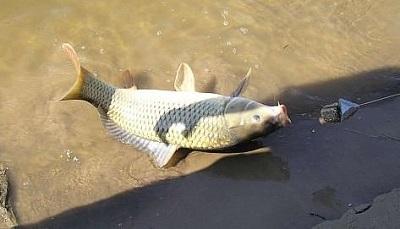
In moderate and medium currents, use a hard-density bait. In stagnant waters, soft and more easily soluble maca briquettes are used. The friction brake setting on the reel is checked and the baitrunner function is turned on. Having found the bait, the carp sucks in the hooks and moves away from the installation to the side, which the fisherman determines by the prolonged and non-stop operation of the alarm. In all cases, the fish hooks itself and does not require a strong control hook from the angler. After giving the signal, the rod is raised upward with the quiver tip and the cord begins to wind, pulling the trophy to the shore with the form.
Carp is a powerful opponent that offers decent resistance and fishing requires constant monitoring of line tension. At the moment of struggle, when the tension is loosened, the fish can twist the cord around the body and cut it with notches on the radial bone of the front fin. The trophy brought to the shallows is brought into a landing net, because it is unlikely that it will be possible to take it in the water with the hands of an elastic and evasive strongman.
Top Most Popular Equipment for Catching Carp on the Feeder
The feeder is used for fishing over long distances. A distinctive feature of the equipment for such gear is the presence of a feeder. Feeder installation is carried out in different ways.
Among All Existing Options Widely Used:
Gardner's paternoster. Ideal Rigging for Mud Bottoms
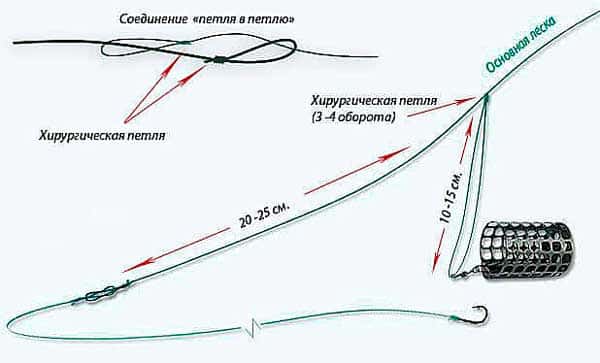
This Carp Rig does not perform Self-Cutting. It is ideal for muddy soil.
The feeder used in this version can even be slightly buried in the silt. In this case, the equipment will continue to transmit the bite with the same sensitivity.
The feeder is fixed to a twist, the length of which is 15 cm. This allows the leash to not overlap with the feeder.
Inline equipment. Effective, Simple and Popular
Inline, which is an Effective, Simple and Popular tool. It consists of a sliding sinker. It can be easily removed and replaced with a light weight feeder.
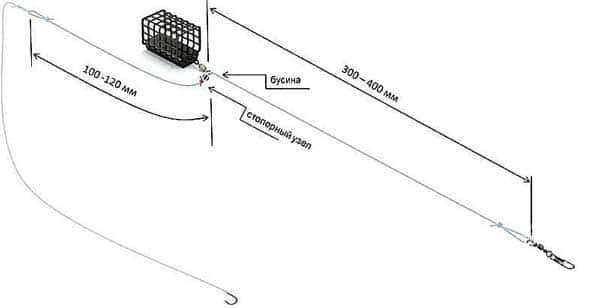
Equipment Nipple. One-Way Feeder Method
A method that is a rig that gets its name from the use of the same-named one-sided feeder, reminiscent of a pacifier.
Granular feed (pellets), previously soaked in water, is pressed into it.
Hooks with bait can also be hidden in the Feeder. In this case, such equipment becomes a “Nipple.”
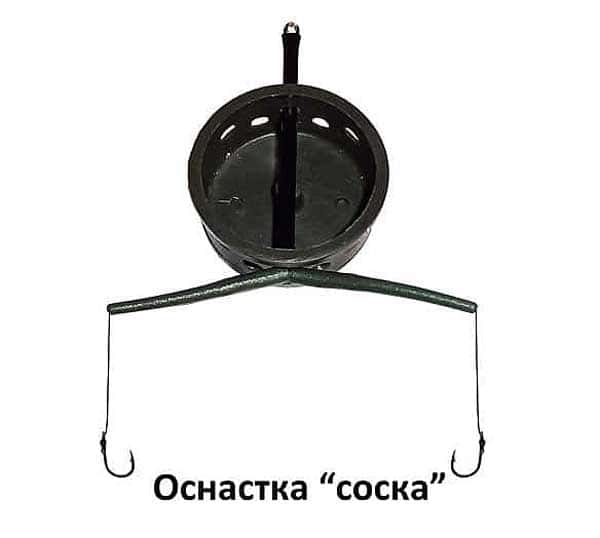
Equipment Symmetrical Loop. Popular Self-cutting Equipment
Being a Self-cutting Equipment. Such equipment for carp perfectly conveys the bite, even if it moves in any direction from the feeder. Most often, such equipment is used in still water.
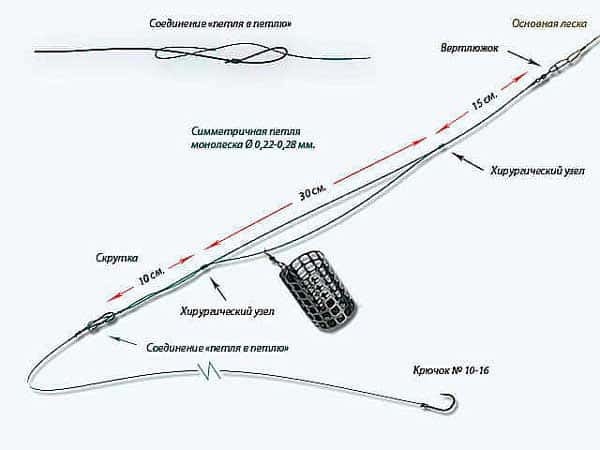
Equipment Asymmetrical Loop for Fishing in Currents
Being an improved version of the previous type of equipment. It is used in strong currents, as it does not allow the line to twist.
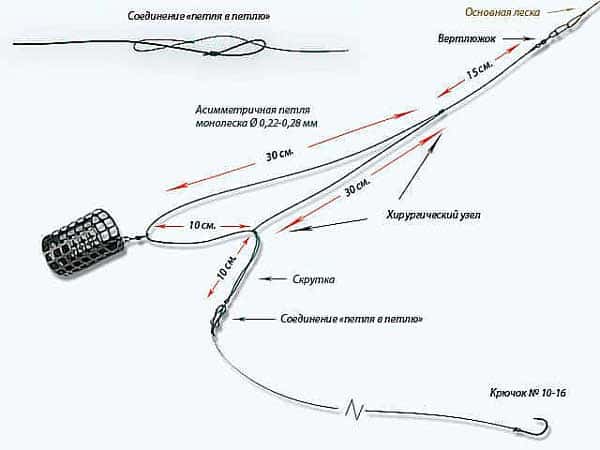
3 ways to improve your fish bite!

Over 15 years of active fishing, I have found many ways to improve the bite, and here are the most effective:
1. Bite activator . This pheromone additive attracts fish most strongly in cold and warm water. The Fish Hungry bite activator has proven itself to be excellent - Read more…
2. Tackle with increased sensitivity . You should first familiarize yourself with the features of using a particular type.
3. Pheromone baits . They attract the attention of fish, stimulate hunger and cause a schooling reflex, which allows you to collect a lot of fish in one place.
You can get the rest of the secrets of successful fishing for free by reading my other materials on the site.
3 ways to improve your fish bite!
Over 15 years of active fishing, I have found many ways to improve the bite, and here are the most effective:
1. Bite activator . This pheromone additive attracts fish most strongly in cold and warm water. The Fish Hungry bite activator has proven itself to be excellent - Read more…
2. Tackle with increased sensitivity . You should first familiarize yourself with the features of using a particular type.
3. Pheromone baits . They attract the attention of fish, stimulate hunger and cause a schooling reflex, which allows you to collect a lot of fish in one place.
You can get the rest of the secrets of successful fishing for free by reading my other materials on the site.
Equipment Helicopter and 2 Knots. Ideal for Currents
This rig is self-clipping;
It is ideal for use on currents;
The bait is placed on a long rod. Therefore, the distance from it to the feeder can reach 1 meter;
At the same time, under the influence of the current, it hangs in the water column if the rod is placed at 45°C to its surface.
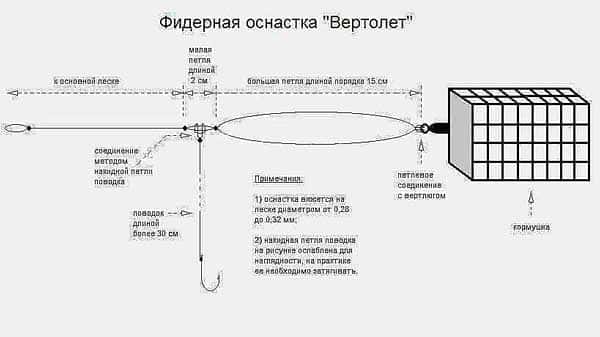
Equipment with Tube - Anti-twist
Which is bent in 2/5 parts. The feeder is fixed directly at the place where it bends.
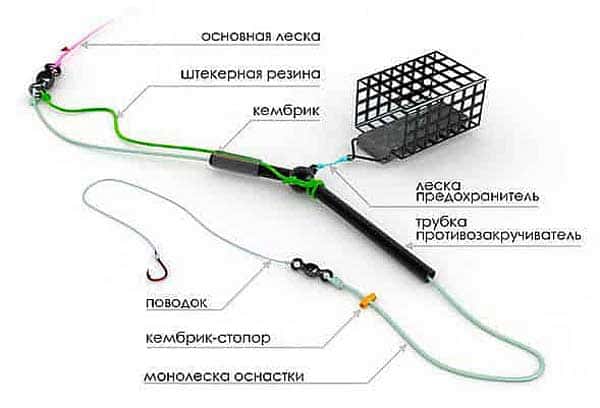
Harvester Equipment: Effective for Catching Carp
Representing a Equipment in which the Feeder is attached to a 100 mm loop. It, in turn, is fixed on the tube with an anti-twist.
All of the equipment listed above allows you to effectively catch carp during long casts.
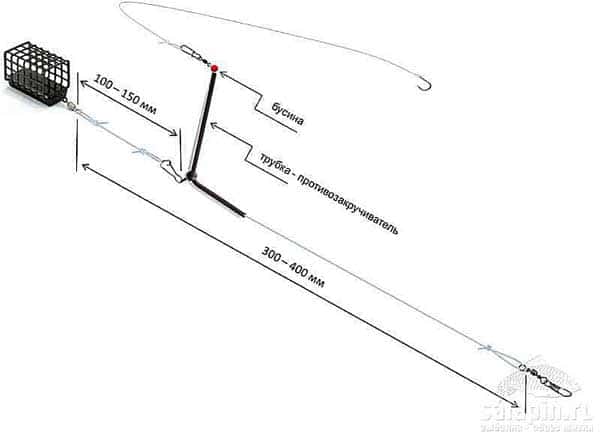
Choosing a fishing spot
Catching carp on top takes place in the same areas where carp are caught. The habitat of the carp is uneven areas of the bottom and large structures located under water. Finding carp in a river is quite difficult; you need to know the catch spots and features of the bottom topography:
- driftwood;
- artificial constructions;
- garbage;
- bottom irregularities.
The carp chooses quiet areas and often lives in algae. Since bottom features are not visible through the water column, the following methods are used to detect a catchable area:
- tapping with a jig;
- sinker dragging;
- echo sounder;
- marker float.
Measure the water depth with a marker float. Also, the fisherman must be aware of changes in depth and changes in bottom topography. Makushatnik is used when fishing not only from the shore, but also from a boat. Donks and side rods are used for this.
Features in summer
Making the summer version is somewhat more complicated and requires more available materials. To make it you will need a reliable weight weighing two to three kilograms, a float, fishing line and a peg. This is due to the greater difficulty of securely attaching gear in the summer . In general, the description of how to set a pike is not much more:
- A weight is tied to one end of the fishing line, which will securely fix the edge in one place. You can use brick or stone.
- After this, a float on a sliding mount is put on the fishing line. It keeps the tackle afloat and signals the location of the supply.
- Having calculated the approximate location and depth in it, a mark is made on the fishing line.
- Half a meter to a meter from this mark, they begin to knit loops for leashes.
- Leashes with bait are hung from these loops, and the end of the fishing line is securely attached to a peg on the shore. Thus, the float prevents the gear from sinking, and the anchor and peg securely fix it. From this type a rubber band emerged - bottom tackle for catching herbivorous fish. The main difference between them is that a rubber cord is attached to the anchor, and a float is not needed in principle.
If the reservoir is unfamiliar and the topology of the bottom is unknown, then you can make a universal supply. To do this, loops begin to be knitted every meter starting from the sinker, and the float-buoy is attached to one of these loops. When the anchor is set and the buoy is attached, it becomes clear which loops the leashes with hooks need to be attached to. This makes it easier to set up in an unfamiliar place and significantly saves time.
Making a makushatnik with your own hands
Let's look at how to make a makushatnik with deaf fixation; for this you need to prepare:
- metal plate;
- cake;
- ring;
- hooks for carp;
- braided thread;
- rubber bands.
To create a carp pulp with your own hands, first make leashes 8-12 cm in size from woven thread with hooks. If the crown measures 4x5 cm, then make 4 leashes. Then a metal plate is cut out according to the size of the crown. A hole is drilled at one end of the plate, a ring is installed in it, to which the main fishing line and leashes with hooks are attached.
Then you need to put the leashes on the sides of the plate and secure the end of the cake with an elastic band. The two shortest leashes are pulled out from the side; they will be installed in front. Then the back end of the cake is secured with an elastic band. Holes for hooks are made in the corners of a piece of cake. Instead of an elastic band, you can screw in self-tapping screws.
The manufacture of a sliding-type crown will require the use of the following materials:
- cake;
- a sinker that can slide;
- braided thread;
- carp hooks;
- silicone stoppers;
- wire;
- swivel with carbine.
First, a sinker is placed on the main line. Below, 2 stoppers are installed to protect the knot. At the end of the thread, a swivel with a carabiner is installed, to which a loop of thread is fixed, the size of which should be. sufficient for a piece of topstock to pass through, in which a longitudinal hole is drilled, and leashes and the main line are passed through it.
Ice fishing stand
Making a pike stand with your own hands is very simple. To do this you need a piece of stick or tube, a piece of hose, fishing line and a hook and sinker. The entire creation process looks like this:
- A hole is punched at one end of the hose through which the fishing line is passed. It is tied with a ring and firmly attached.
- A pre-prepared piece of stick or pipe is inserted into the hose. It should be 20-30 centimeters long. It is advisable that the hose fits tightly onto the stick, this will allow the end of the fishing line to be securely fixed.
- After fixing the hose, a fishing line is wound around it.
- A sinker and a hook are rigidly attached to the fishing line. The delivery is ready.
You can make such tackle in literally half an hour from scrap materials; there are no special requirements for them. The only thing is that it is advisable to attach the hook to the main line through a leash - tying a new hook in the cold is an unpleasant task.
In essence, winter supplies are universal; in addition to catching pike, they can be used for carp, carp or bream. It is enough to feed the place and install the supply.
Fishing technique and tactics
Having chosen a fishing area on a reservoir, you must first feed it. Since the makha gets wet after 30-40 minutes, you need to throw odorous mixtures into the water in advance. If sunflower cake is used, then the area is fed with crushed seeds. When choosing how to catch carp using cake more effectively, you can try smearing the cake with halva, so the fish will detect the bait faster. They make mugs, set-ups, and girders from the top, then throw the gear into the river, put the fishing rod on a stand and set the tension of the main line.
Then turn on the baitrunner if the reel is equipped with one. The arrow points to the baitrunner lever. When the fish finds the top and touches it, the tip of the rod will tremble. The fisherman should pay attention to this, but should only hook after the fish has taken the bait and is hooked. With this fishing scheme, fishing is carried out confidently; the main line should not weaken.
The clutch can be used to loosen the spool to allow the carp to shed a little thread. When you feel the fish give in, slowly apply the brake. At the last stage, a landing net is used, because a fish, sensing a strand near the shore, can make a powerful jerk.
How to choose the right makuha
When choosing what carp will bite on, many fishermen stop at the top of the fish. This is a cake from the seeds of plants that produce oil. Macukha can be made from any seeds containing oil. Sunflower cake is used to catch carp on the top of the forest.
When choosing makukha, take into account its hardness. Soft cake is used in ponds because... after 1-1.5 hours it begins to limp and forms a spot, the smell of which the carp will smell and come closer. When choosing a top, you want it to crumble a little and make a dull sound when tapped on the table.
Medium-hard cake is used on a river with a current. It will limp for 2-3 hours. The dust should not fall off; when tapped, it makes a ringing sound. On rivers with strong currents, hard cake is used. It lasts for 4-6 hours and will lure fish to the fishing area. This cake knocks loudly and does not crumble.
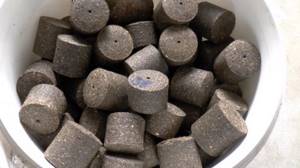
Sometimes they sell loose powder. It is used to knead bait or make a dense dough from it, which is used in a stagnant body of water. In winter, the time for the cake to become soggy increases by 2 hours, so hard pulp is not used.
There are these types of cake:
- Sunflower. The most common, has a low price, and is always on sale. It has a distinct smell and pleasant taste.
- Linen. It costs more due to the complexity of manufacturing.
- Soy. Rarely available for sale, but contains a lot of protein.
The flour must be fresh. When buying it, you can taste it; it should be slightly sweet. If the cake is bitter, it means it is not fresh and will not attract fish. If the cake is sold in briquettes, then you need to pay attention to the production date of the product.

There are different ways to increase the efficiency of fly fishing. To enhance the smell of the cake and its resistance to souring, you can pour oil over it. If you dip the top of the grain in oil and pull it out, the souring time will increase by an hour. You can soak the cake in oil to create air bubbles, then its resistance to souring will increase for 4 hours.

